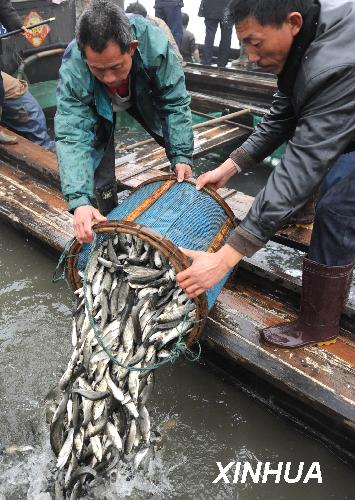Millions of algae-eating fish fry are being released into China's third largest freshwater lake, Taihu, in a five-day campaign to curb the blue-green growth.
 |
|
Millions of algae-eating fish fry were released into China's third largest freshwater lake, Taihu, on February 19, 2009, in a five-day campaign to curb the blue-green growth. |
The 2,400-square-km lake is a major drinking water source in east China's Jiangsu Province. Blue-green algae choked the lake in 2007, reducing drinking water supplies to 2 million residents in Wuxi City.
Four cities surrounding the lake -- Suzhou, Wuxi, Changzhou and Huzhou -- joined the campaign, which is to end Monday. About 10 million fish such as silver carp and grass carp will be released, said Lin Jianhua, head of the Taihu Lake Fishing Administration.
He said the campaign, the largest of its kind, will cost some 7.4 million yuan (US$1.08 million), to be paid for with government funds and public donations.
He said although sewage pollution had largely been contained through years of efforts, the degradation of the water remained a major problem.
The province spent 5 billion yuan to build 3,500 km of sewage pipes, which had effectively prevented direct sewage discharges into the Taihu Lake Basin, according to provincial environmental authorities.
More than 170 sewage plants had been built or were under construction in the basin, with total daily disposal capacity of 4 million tonnes by the end of 2008.
Lin said the lake administration had also achieved the closure of 78 percent of fish-breeding activities in the lake, which were cited as a key factor in the nitrogen pollution that spurred the growth of algae.
"The biological treatment using the algae digestion ability of the fish is expected to fundamentally rehabilitate the lake," he said.
He said a silver carp could consume 50 kg of algae and other plankton life in the course of gaining 1 kg in weight. Based on such parameters, he said, researchers had calculated that it would take 100 million fish to clean the lake.
(Xinhua News Agency February 20, 2009)